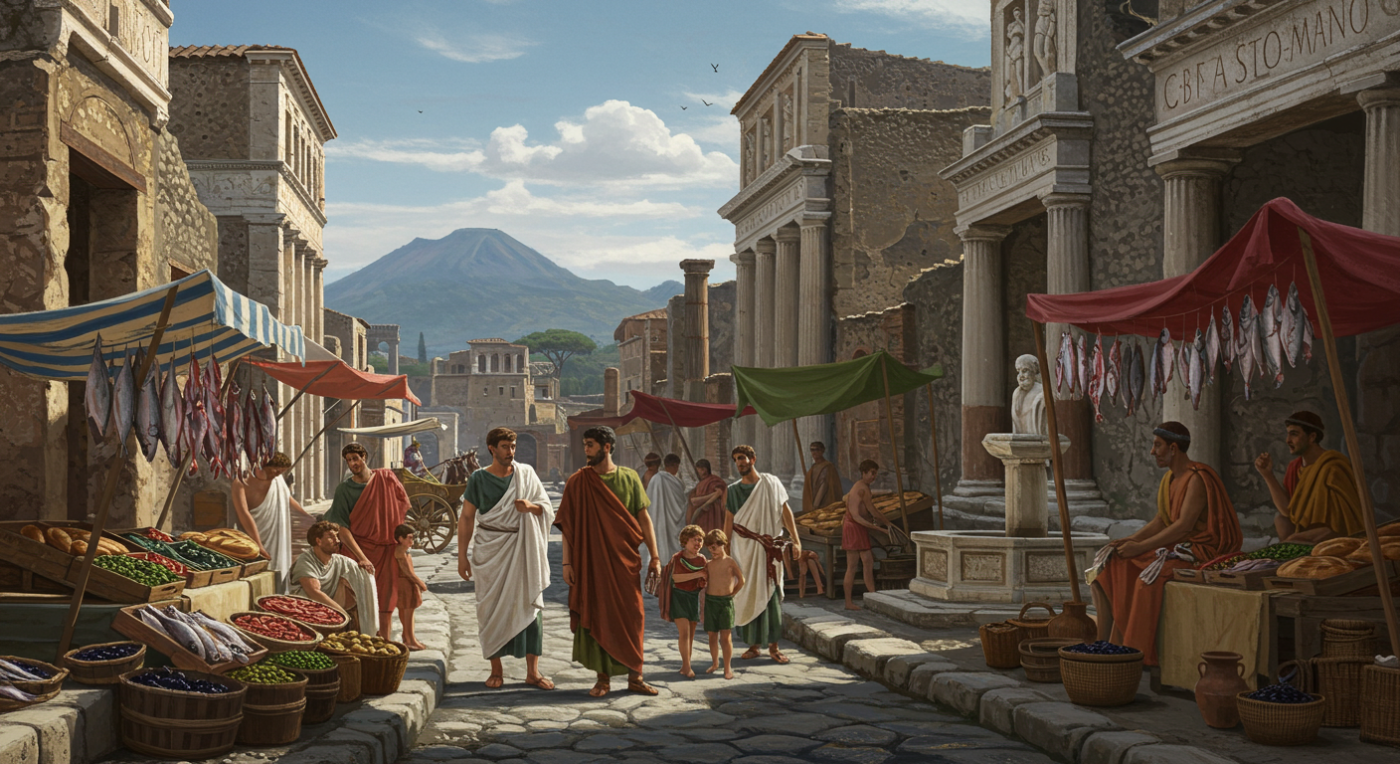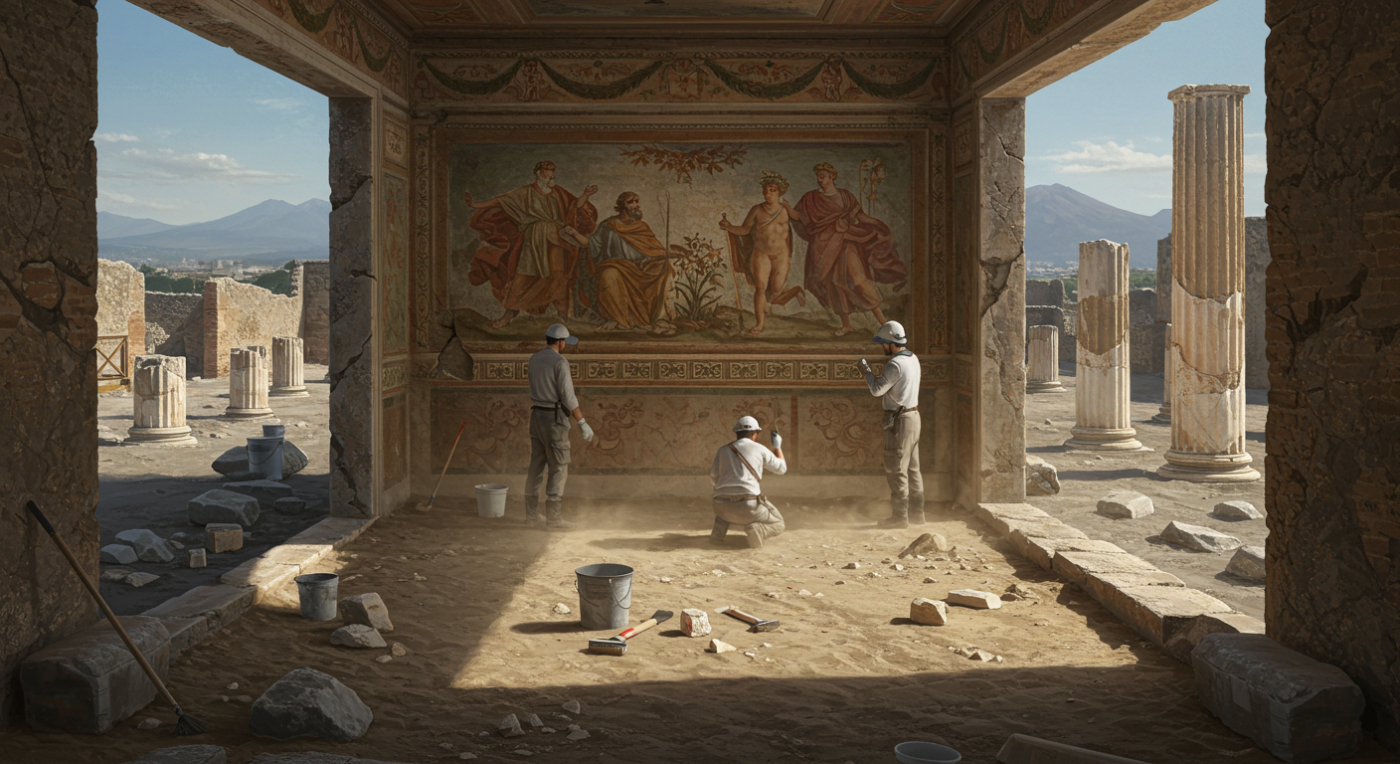Introduction
Pompeii, the Roman city buried under the ashes of Mount Vesuvius in 79 AD, represents an invaluable treasure for understanding ancient life. This article will take you on a journey through Pompeii’s history, exploring its archaeological and artistic significance while delving into the lifestyle of its wealthiest citizens.
A Day Like Any Other in Pompeii: Before the Disaster
On August 24, 79 AD, the citizens of Pompeii woke up like any other morning, unaware that it would be their last day. The marketplace was bustling, the baths welcomed their first visitors, and in the patrician villas, business discussions and lavish banquets were being prepared. However, an ominous sign was already in the air: light tremors had been felt in the hours before, a warning of the impending catastrophe.

Pliny the Younger, an eyewitness to the eruption, described the moment when the column of smoke rose into the sky:
“A cloud was ascending – I cannot say with certainty from which tree it was more like in shape – but it resembled a pine tree: for, shooting up to a great height like a trunk, it then spread out at the top in a series of branches.”
A few hours later, the city would be swallowed by a rain of pumice and scorching ashes, condemning it to oblivion for nearly two millennia.
History of Pompeii
Pompeii was founded by the Oscans around the 7th century BC on a plateau formed by a lava flow near the Sarno River. The city grew rapidly, becoming an important commercial and strategic hub, influenced by various cultures, including the Greeks and Etruscans. Conquered by the Romans in the 3rd century BC, Pompeii became a thriving commercial city, exporting oil and wine throughout the Mediterranean. Its importance grew further when it became a Roman colony, known as Cornelia Veneria Pompeianorum, after its conquest by Sulla in 89 BC.
The Eruption of Mount Vesuvius
The eruption of Mount Vesuvius in 79 AD marked the end of Pompeii, burying it under a thick layer of ash and pumice. This catastrophic event devastated the region but paradoxically preserved the city and its everyday life, offering a unique window into ancient Roman civilization.

The Luxury of Ancient Rome: Villas and Mosaics of Pompeii
The wealthiest citizens of Pompeii lived in lavish homes that reflected Roman and Greek lifestyles. Their villas were adorned with stunning mosaics and frescoes, depicting scenes of daily life, battles, and natural landscapes. One of the most famous examples is the Alexander Mosaic, found in the House of the Faun, which portrays the Battle of Issus between Alexander the Great and Darius III of Persia.
Design and Lifestyle
The homes of the wealthy were designed to showcase their affluence and influence. Interiors were often decorated with precious marble and statues, while gardens were maintained as peaceful oases in the heart of the city. Mosaics not only decorated floors and walls but also told mythological and historical stories, reflecting the culture and education of their owners.
Examples of Mosaics and Frescoes
- Mosaic of the Seven Sages: This mosaic, found in the Villa of Titus Siminius Stephanus, depicts the Seven Sages of antiquity gathered in an olive grove, with a philosopher explaining the celestial globe. The mosaic is an example of how Roman art could combine philosophy and aesthetic beauty.
- Frescoes of the Villa of the Mysteries: These famous frescoes, dating back to 70–60 BC, are considered among the most important examples of Roman art. They depict an initiation ceremony into the Mysteries of Dionysus, possibly linked to a wedding rite. The vivid colors and painting techniques have allowed their beauty to endure despite the centuries.

The Daily Life of Wealthy Citizens
The day of Pompeii’s wealthiest citizens began early with a visit to the barbershop, where they would discuss daily events. The baths were a common place for socializing and conducting business, as well as for maintaining personal hygiene in an era without running water in homes. Dinners were often elaborate, featuring dishes made of fish, meat, and sweets, accompanied by wine and music.
Beyond business and leisure, religion also played a central role in the lives of Pompeians. Many homes had small lararia, household altars dedicated to guardian deities, where daily offerings were made.
New Discoveries and Restorations
Recently, new areas of Pompeii have been uncovered, including a rarely seen blue-painted room, which may have been a shrine, and a luxurious private bath complex with rooms for hot and cold baths. Additionally, archaeologists have unearthed new inscriptions on walls, revealing previously unknown details about public and private life.
Another significant discovery involves a tavern with frescoes depicting the menu of the time, suggesting that street food culture was already popular among Pompeians.

Conclusion
Pompeii offers a unique journey through time, allowing us to explore the daily life and art of ancient Rome. The villas and mosaics of the wealthiest citizens reveal a luxurious and refined lifestyle that reflects the grandeur of Roman civilization. The ongoing excavations of Pompeii continue to unveil secrets of ancient life, making it one of the most fascinating archaeological sites in the world.
FAQs
- When was Pompeii founded?
Pompeii was founded by the Oscans in the 7th century BC. - What caused the destruction of Pompeii?
Pompeii was destroyed by the eruption of Mount Vesuvius in 79 AD. - Which cultures influenced Pompeii?
Pompeii was influenced by various cultures, including the Greeks, Etruscans, and Romans. - How did Pompeii’s wealthiest citizens live?
The wealthiest citizens lived in luxurious villas adorned with mosaics and frescoes and participated in social events such as banquets and visits to the baths. - Why is Pompeii important for understanding ancient life?
Pompeii is important because it provides a unique glimpse into daily life in ancient Rome, thanks to its preservation after the eruption of Mount Vesuvius.
Share your photo and get featured on our social media.
Upload now and shine with The Glanz!